The global motor bearings market is projected to expand from USD 8.6 billion in 2025 to nearly USD 17.7 billion by 2035, recording a CAGR of 7.5% during the assessment period. The motor bearings industry outlook emphasizes the importance of precision-engineered bearings in enhancing efficiency across various end-use sectors. Bearings are relied upon for reducing friction, enabling smooth rotation, and extending operational life of motors used in critical applications ranging from manufacturing and power generation to automotive and renewable energy projects. The rise in sales of motor bearings illustrates the strengthening adoption of durable mechanical components capable of supporting high-load and high-speed environments.
The period between 2025 to 2030 is expected to be shaped by accelerating electrification of vehicles and the growth of industrial automation across Asia, Europe, and North America. Bearings are increasingly deployed in electric motors, robotics, conveyors, and wind turbines, where stability and energy efficiency are essential. Automotive manufacturers are emphasizing lightweight and high-performance bearing designs to improve range and reliability of electric vehicles. Industrial operators, on the other hand, are investing in bearings that can deliver improved uptime and predictive maintenance compatibility, ensuring that equipment remains productive while avoiding costly breakdowns.
Innovations are gradually reshaping the competitive field. Ceramic bearings, hybrid bearings, and sensor-embedded solutions are becoming integral to next-generation equipment. These designs improve heat resistance, reduce lubrication requirements, and enable real-time monitoring, allowing engineers to optimize maintenance schedules. The growing reliance on connected machinery in factories is further supporting adoption of intelligent bearing systems, reinforcing their role as indispensable components in Industry 4.0 production environments. Suppliers are developing modular and application-specific product lines to cater to diverse requirements spanning renewable power installations, precision manufacturing, and electrified mobility platforms.
Regional demand patterns shows varied priorities. In Asia, the expansion of manufacturing capacity, rapid vehicle electrification, and investment in renewable power systems underpin the largest share of bearing demand. Europe’s strong focus on wind power, offshore energy projects, and energy-efficient industrial systems is strengthening sales of large-diameter and high-capacity bearings. North America is prioritizing factory modernization and EV infrastructure growth, sustaining strong demand for precision bearings in both automotive and industrial contexts. Each region’s growth path is influenced by policy support, industrial activity, and the scale of electrification initiatives, underscoring the global nature of this market’s expansion. By 2030 to 2035, the pace of adoption is expected to accelerate further, particularly in wind turbine applications, variable-speed drives, and high-load electric machinery. Market expansion will also be reinforced by replacement demand as aging equipment requires upgrades with higher-quality bearings. Vendors prioritizing advanced materials, predictive monitoring capabilities, and application-specific engineering will secure long-term competitive positioning, ensuring steady revenue capture across sectors.
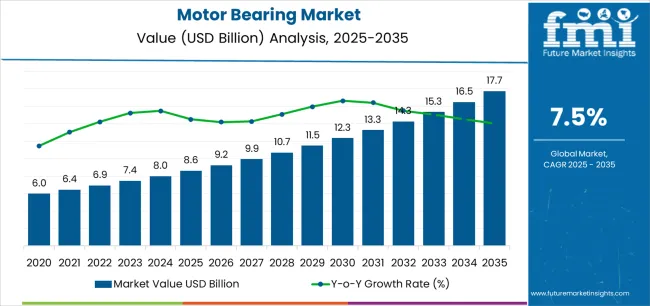
Between 2025 and 2030, the motor bearing market is projected to expand from USD 8.6 billion to USD 12.4 billion, resulting in a value increase of USD 3.8 billion, which represents 41.3% of the total forecast growth for the decade. This phase of development will be shaped by rising demand for electric vehicle platforms and e-mobility component solutions, product innovation in hybrid ceramic and sensor-integrated bearing systems, as well as expanding integration with smart manufacturing and condition monitoring technologies. Companies are establishing competitive positions through investment in advanced material technologies, digital monitoring solutions, and strategic market expansion across automotive, industrial automation, and renewable energy applications.
From 2030 to 2035, the motor bearings market is forecast to grow from USD 12.4 billion to USD 17.8 billion, adding another USD 5.4 billion, which constitutes 58.7% of the ten-year expansion. This period is expected to be characterized by the expansion of specialized precision bearing systems, including advanced ceramic materials and integrated sensor technologies tailored for specific motor requirements, strategic collaborations between bearing manufacturers and equipment producers, and an enhanced focus on energy efficiency and predictive maintenance capabilities.
| Metric | Value |
|---|---|
| Market Value (2025) | USD 8.6 billion |
| Market Forecast Value (2035) | USD 17.8 billion |
| Forecast CAGR (2025-2035) | 7.5% |
The motor bearing market grows by enabling industrial operators to achieve superior equipment reliability and operational efficiency while meeting evolving electrification demands. Motor manufacturers face mounting pressure to improve energy efficiency and equipment longevity, with advanced bearing solutions typically providing 20-35% better performance over conventional bearing systems, making precision bearings essential for electric motor and high-speed e-drive applications. The electrification movement's need for compact, efficient bearing solutions creates demand for advanced products that can enhance motor performance, reduce energy consumption, and ensure consistent operation across demanding operational conditions.
Government initiatives promoting energy efficiency standards and eco-friendly manufacturing practices drive adoption in automotive, industrial, and renewable energy applications, where bearing performance has a direct impact on motor efficiency and system reliability. The global shift toward electric vehicles and automation accelerates motor bearing demand as manufacturers seek high-precision components that enable superior performance and extended service life. Higher initial costs and material availability challenges compared to standard bearing solutions may limit adoption rates among price-sensitive small manufacturers and regions with limited access to advanced bearing technologies.
The motor bearings market is segmented by product type, bearing material, bearing size, sales channel, end-use, and region. By product type, the motor bearings market is divided into ball bearings, roller bearings (including cylindrical, spherical, tapered, needle, and thrust roller), and coated/specialty bearings. Based on bearing material, the motor bearings market is categorized into steel, hybrid (steel rings with ceramic balls), full ceramic, and coated/others. By bearing size (bore diameter), the motor bearings market includes small (≤30 mm), medium (30-100 mm), and large (>100 mm). Based on sales channel, the motor bearings market is segmented into OEM and aftermarket. By end-use, the motor bearings market encompasses manufacturing & general industry, automotive (including EV), HVAC & building systems, power generation & renewables, food & pharma, mining & quarrying, oil & gas, and aerospace & marine. Regionally, the market is divided into Asia Pacific, Europe, North America, Latin America, and the Middle East & Africa.
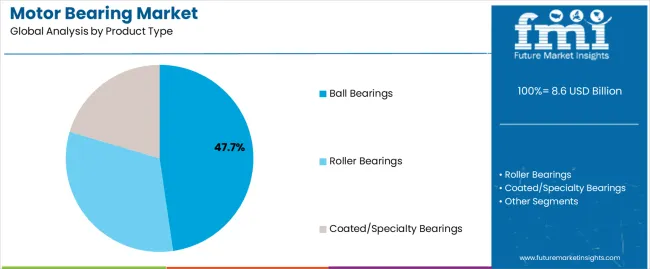
The ball bearings segment represents the dominant force in the motor bearing market, capturing approximately 47.7% of total market share in 2025. This advanced category encompasses spherical rolling element bearings featuring precise ball geometry, optimized contact angles, and superior speed capabilities, delivering comprehensive performance characteristics with minimal friction and enhanced efficiency. The ball bearings segment's market leadership stems from its exceptional versatility across diverse motor applications, superior high-speed performance capabilities, and compatibility with electric motor designs that require minimal friction and precise rotational accuracy.
The roller bearings segment maintains a substantial 45.0% market share, serving applications requiring high radial load capacity and durability in demanding industrial environments. Within roller bearings, cylindrical roller bearings account for 13.0% market share, offering superior radial load handling for heavy-duty motor applications. Spherical roller bearings account for 11.0% of the market, offering self-aligning capabilities for installations prone to misalignment. Tapered roller bearings hold a 10.0% market share, offering a combination of radial and axial load capacity for complex loading conditions. Needle roller bearings account for 7.0% market share, featuring compact designs for space-constrained motor configurations. Thrust roller bearings account for 4.0% of the market, specializing in axial load applications.
Key advantages driving the ball bearings segment include:
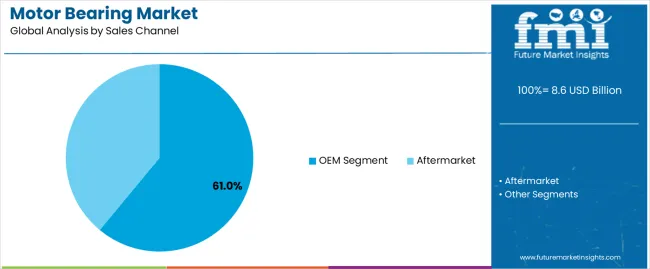
The OEM segment represents the leading distribution channel in the motor bearing market, capturing approximately 61% of total market share in 2025. This critical channel encompasses direct supply relationships between bearing manufacturers and motor producers, equipment manufacturers, and system integrators who incorporate bearings into new production equipment, delivering integrated solutions with optimized specifications and comprehensive technical support. The OEM segment's dominance reflects the primary role of new equipment production in driving bearing demand, strategic partnerships between bearing suppliers and equipment manufacturers, and the preference for engineered bearing solutions specified during product design phases.
The aftermarket segment maintains a substantial 39.0% market share, serving maintenance, repair, and overhaul requirements across the installed base of motors and equipment, where bearing replacement represents a critical maintenance activity for ensuring continued operational reliability and preventing unplanned downtime. This channel benefits from the large population of operating motors requiring periodic bearing replacement, increasing equipment utilization rates that accelerate bearing wear, and growing adoption of predictive maintenance strategies that identify bearing replacement needs before failure occurs.
Key factors driving OEM channel dominance include:
The motor bearings market is driven by three concrete demand factors tied to electrification and efficiency outcomes. First, accelerating electric vehicle adoption creates expanding requirements for high-performance motor bearings, with global EV production growing 30-45% annually in major automotive markets worldwide, requiring specialized bearing solutions for electric drive systems and auxiliary motors. Second, industrial automation and robotics expansion drive demand for precision bearing solutions, with manufacturing facilities implementing 25-40% more automated equipment annually while requiring high-speed, low-friction bearings that enable precise motion control and extended operational life. Third, energy efficiency regulations and motor performance standards accelerate adoption of advanced bearing technologies, with IE3/IE4 motor efficiency requirements reducing friction losses by 15-25% compared to standard motors through optimized bearing selection and design integration.
Market restraints include raw material cost volatility affecting bearing production economics, with bearing steel and ceramic material prices fluctuating 20-35% annually based on global commodity markets, creating cost pressure for manufacturers and uncertainty for equipment producers managing component budgets. Competition from low-cost bearing manufacturers poses margin pressure, particularly in standard bearing segments where Chinese and regional producers offer 30-50% lower pricing than established international brands, challenging premium positioning strategies and requiring differentiation through quality assurance and technical service capabilities. Supply chain complexity affecting component availability creates operational challenges, particularly for specialized bearing materials and precision components where manufacturing lead times extend 8-16 weeks for custom specifications and technical requirements.
Key trends indicate accelerated sensor integration and smart bearing adoption across industrial applications, particularly in predictive maintenance environments where embedded sensor technology enables condition monitoring, vibration analysis, and remaining useful life prediction that reduces unplanned downtime by 40-60% compared to reactive maintenance approaches. Ceramic and hybrid bearing technology advancement trends toward expanded adoption in high-speed electric motor applications, where ceramic rolling elements provide 20-30% speed increases and 50% longer service life compared to conventional steel bearings through reduced friction and enhanced thermal properties. The motor bearings market thesis could face disruption if magnetic bearing or alternative contact-free bearing technologies achieve cost-competitive implementation in mainstream motor applications, potentially displacing conventional rolling element bearings in specific high-performance segments and reshaping long-term technology preferences.
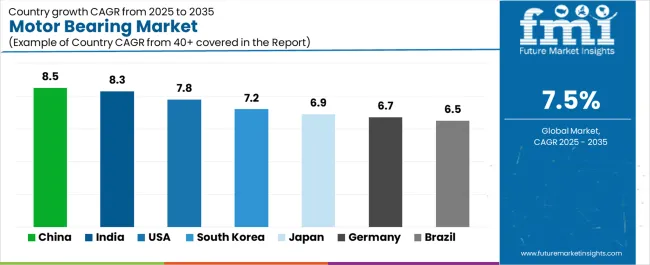
| Country | CAGR (2025-2035) |
|---|---|
| China | 8.5% |
| India | 8.3% |
| United States | 7.8% |
| South Korea | 7.2% |
| Japan | 6.9% |
| Germany | 6.7% |
| Brazil | 6.5% |
The motor bearing market is gaining momentum worldwide, with China taking the lead thanks to massive EV platform expansion and robotics/automation build-out across manufacturing sectors. Close behind, India benefits from Make-in-India localization initiatives and metro/wind infrastructure additions, positioning itself as a strategic growth hub in the Asia-Pacific region. The USA shows strong advancement, where efficiency retrofit programs and EV & aerospace sector growth strengthen its role in North American advanced manufacturing supply chains. Germany demonstrates robust growth through Industry 4.0 implementation and e-mobility production line establishment, signaling continued investment in precision manufacturing infrastructure. Meanwhile, Brazil stands out for its automotive sector recovery and grid/HVAC upgrade programs combined with industrial modernization, while Japan and South Korea continue to record consistent progress driven by precision motor manufacturing and semiconductor/battery facility expansion.
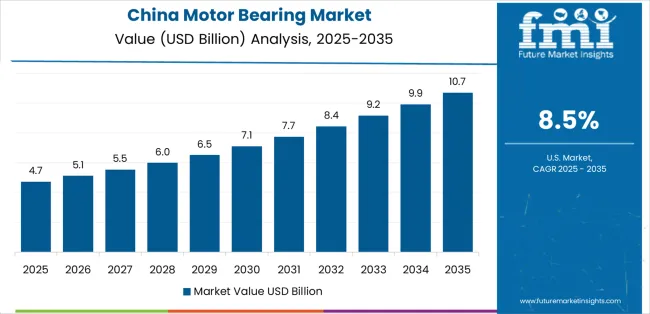
China demonstrates the strongest growth potential in the Motor Bearing Market with a CAGR of 8.5% through 2035. The country's leadership position stems from aggressive electric vehicle production scaling, intensive robotics and automation deployment across manufacturing facilities, and comprehensive industrial modernization programs driving adoption of precision bearing systems. Growth is concentrated in major industrial regions, including Pearl River Delta, Yangtze River Delta, Beijing-Tianjin-Hebei, and Chengdu-Chongqing, where automotive production, electronics manufacturing, and machinery fabrication sectors are implementing advanced bearing solutions for electric motors and automated equipment. Distribution channels through bearing distributors, equipment manufacturers, and direct industrial relationships expand deployment across manufacturing clusters and automotive production sites. The country's Made in China 2025 and dual circulation strategies provide policy support for manufacturing technology advancement, including support for domestic bearing production capacity and quality improvement initiatives.
Key market factors:
In major industrial centers, automotive manufacturing zones, and infrastructure corridors, the adoption of motor bearing systems is accelerating across vehicle production facilities, machinery manufacturing, and renewable energy projects, driven by Make-in-India localization initiatives and infrastructure modernization programs. The motor bearings market demonstrates strong growth momentum with a CAGR of 8.3% through 2035, linked to comprehensive manufacturing expansion and increasing focus on domestic production capabilities. Indian manufacturers are implementing precision bearing solutions and quality management systems to improve equipment reliability while meeting international performance standards in key industrial regions including Gujarat, Maharashtra, Tamil Nadu, and Haryana. The country's automotive mission and renewable energy targets create sustained demand for bearing solutions, while increasing emphasis on local value addition drives adoption of domestic bearing production that enhances supply security and cost competitiveness.
The USA market leads in advanced bearing technology innovation based on integration with predictive maintenance systems and sophisticated condition monitoring platforms for enhanced equipment reliability. The country shows solid potential with a CAGR of 7.8% through 2035, driven by industrial efficiency retrofit programs and expanding electric vehicle and aerospace sector requirements across major manufacturing regions, including the Midwest industrial belt, Southeast automotive corridor, Northeast aerospace cluster, and Southwest technology hubs. American manufacturers are adopting sensor-integrated bearing solutions for compliance with energy efficiency standards and equipment reliability targets, particularly in high-value manufacturing operations requiring precision components and in sectors with stringent quality requirements mandating certified bearing performance. Technology deployment channels through industrial distributors, equipment manufacturers, and maintenance service providers expand coverage across diverse industrial applications.
Leading market segments:
Motor bearing market in South Korea demonstrates sophisticated implementation focused on semiconductor fabrication equipment and battery manufacturing systems, with documented integration of precision bearing solutions achieving minimal vibration and contamination control in cleanroom manufacturing operations. The country maintains steady growth momentum with a CAGR of 7.2% through 2035, driven by expanding battery production facilities and semiconductor manufacturing capacity aligned with national technology leadership objectives. Major industrial regions, including Seoul Capital Area, Ulsan, Changwon, and Pohang, showcase advanced deployment of high-precision bearings that integrate seamlessly with automated manufacturing equipment and quality control requirements.
Key market characteristics:
In major industrial centers, automotive production regions, and precision machinery clusters, manufacturers are implementing advanced bearing programs to enhance equipment precision and meet stringent quality standards, with documented case studies showing extended equipment life and improved dimensional accuracy in demanding manufacturing environments. The motor bearings market shows solid growth potential with a CAGR of 6.9% through 2035, linked to ongoing factory automation initiatives, precision motor upgrade requirements, and increasing focus on manufacturing quality enhancement solutions. Japanese manufacturers are adopting ultra-precision bearing systems and integrated monitoring technologies to maintain production quality while complying with energy efficiency regulations in advanced manufacturing environments including Kanto, Chubu, Kansai, and Kyushu industrial regions.
Market development factors:
Motor bearing market in Germany demonstrates sophisticated implementation focused on smart factory systems and e-mobility production infrastructure, with documented integration of sensor-equipped bearings achieving real-time condition monitoring and predictive maintenance capabilities in automated manufacturing operations. The country maintains steady growth momentum with a CAGR of 6.7% through 2035, driven by Industry 4.0 digitalization programs and manufacturers' emphasis on equipment efficiency principles aligned with eco-friendly manufacturing practices. Major industrial regions, including Bavaria, Baden-Württemberg, North Rhine-Westphalia, and Lower Saxony, showcase advanced deployment of intelligent bearing systems that integrate seamlessly with manufacturing execution systems and equipment management platforms.
Key market characteristics:
Expanding industrial sector in Brazil demonstrates growing implementation of motor bearing systems, with documented case studies showing 15-25% maintenance cost reduction through adoption of quality bearing solutions in manufacturing and infrastructure applications. The country's industrial infrastructure in major producing regions, including São Paulo, Minas Gerais, Rio Grande do Sul, and Paraná, showcases integration of modern bearing technologies with existing equipment base, leveraging expertise in automotive manufacturing and industrial machinery operations. Brazilian manufacturers emphasize bearing reliability and technical support, creating demand for dependable bearing sources that support operational commitments and equipment uptime requirements. The motor bearings market maintains solid growth through focus on automotive sector recovery and infrastructure investment, with a CAGR of 6.5% through 2035.
Key development areas:
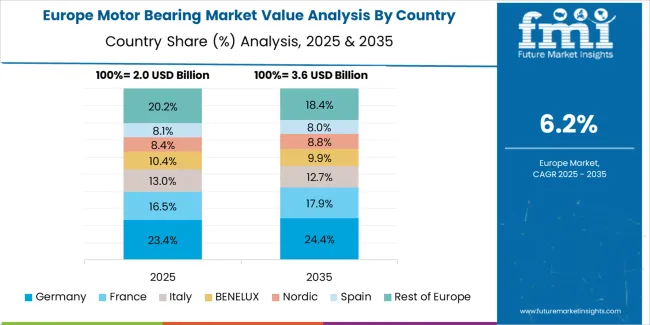
The motor bearing market in Europe is projected to grow from USD 2.7 billion in 2025 to USD 5.0 billion by 2035, registering a CAGR of 6.5% over the forecast period. Germany is expected to maintain its leadership position with a 26.0% market share in 2025, declining slightly to 25.6% by 2035, supported by its advanced manufacturing infrastructure and major industrial automation programs, including Bavaria, North Rhine-Westphalia, and Baden-Württemberg industrial regions.
Italy follows with a 16.0% share in 2025, projected to reach 16.3% by 2035, driven by machinery exports and HVAC retrofit programs implementing efficient motor systems. France holds a 14.0% share in 2025, expected to rise to 14.2% by 2035 through renewable energy expansion and rail electrification projects. The United Kingdom commands a 13.0% share in 2025, reaching 13.1% by 2035, backed by utility efficiency programs and EV supply-chain investments. Spain accounts for 9.0% in 2025, rising to 9.2% by 2035 on automotive component manufacturing hubs and wind energy additions. The Nordics and Benelux region together represent 12.0% in 2025, expanding to 12.1% by 2035 on precision manufacturing and offshore wind installations. The Rest of Europe region is anticipated to hold 10.0% in 2025, adjusting to 9.5% by 2035, attributed to steady bearing adoption across Central and Eastern European industrial upgrades.
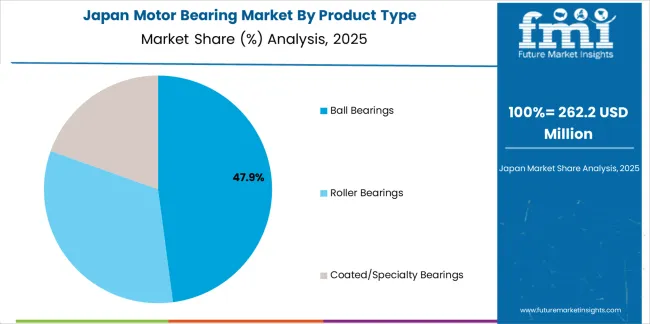
The Japanese motor bearing market demonstrates a mature and quality-focused landscape, characterized by sophisticated integration of ball bearing and roller bearing systems with existing precision manufacturing infrastructure across automotive production operations, industrial machinery facilities, and advanced equipment manufacturing communities. Japan's emphasis on manufacturing excellence and equipment reliability drives demand for certified motor bearings that support quality commitments and performance expectations in premium domestic industrial standards. The motor bearings market benefits from strong partnerships between international bearing manufacturers and domestic industrial associations including machinery cooperatives, creating comprehensive service ecosystems that prioritize bearing precision and technical support programs. Manufacturing centers in Tokyo, Osaka, Nagoya, and other major industrial areas showcase advanced bearing implementations where precision programs achieve 99% operational reliability through tight tolerance control and integrated quality management platforms.
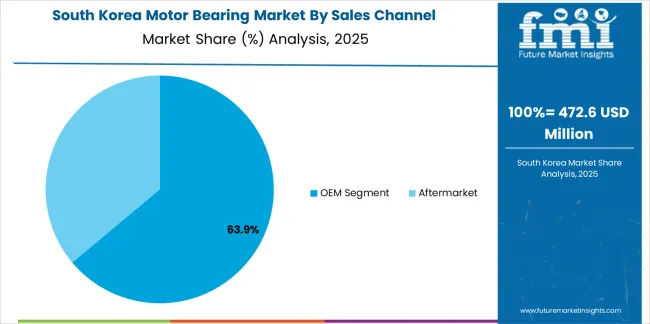
The South Korean motor bearing market is characterized by growing international technology provider presence, with companies maintaining significant positions through comprehensive technical support and application engineering capabilities for automotive and semiconductor manufacturing applications. The motor bearings market demonstrates increasing emphasis on high-precision bearings and sensor-integrated solutions, as Korean manufacturers increasingly demand certified motor bearings that integrate with domestic advanced manufacturing systems and sophisticated equipment control platforms deployed across major industrial facilities. Regional bearing distributors are gaining market share through strategic partnerships with international manufacturers, offering specialized services including application engineering support and performance validation programs for intensive automated manufacturing operations. The competitive landscape shows increasing collaboration between multinational bearing companies and Korean industrial technology specialists, creating hybrid service models that combine international manufacturing expertise with local application knowledge and precision engineering systems.
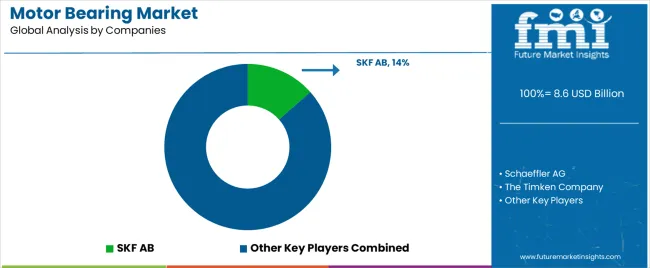
The motor bearing market features approximately 20-30 meaningful players with moderate concentration, where the top three companies control roughly 30-35% of global market share through established distribution networks and comprehensive product portfolios. Competition centers on bearing precision, material innovation, and technical support capabilities rather than price competition alone. SKF AB leads with approximately 13.5% market share through its comprehensive bearing portfolio and industrial service capabilities.
Market leaders include SKF AB, Schaeffler AG, and The Timken Company, which maintain competitive advantages through global manufacturing infrastructure, extensive technical expertise, and deep knowledge in bearing engineering across multiple industrial segments, creating quality and reliability advantages with equipment manufacturers and industrial customers. These companies leverage research and development capabilities in advanced materials and ongoing customer support relationships to defend market positions while expanding into smart bearing technologies and condition monitoring solutions.
Challengers encompass NSK Ltd. and NTN Corporation, which compete through specialized bearing designs and strong regional presence in key industrial markets. Product specialists, including JTEKT Corp., Nachi-Fujikoshi Corp., and NRB Bearings Ltd., focus on specific bearing types or regional applications, offering differentiated capabilities in precision manufacturing, specialized materials, and customized bearing configurations. Regional players and emerging bearing manufacturers create competitive pressure through localized production advantages and responsive service capabilities, particularly in high-growth markets including India and China, where proximity to industrial customers provides advantages in delivery responsiveness and application engineering support.
Motor bearings represent precision mechanical components that enable equipment manufacturers to achieve 20-35% better performance compared to conventional bearing solutions, delivering superior operational efficiency and equipment reliability with enhanced speed capabilities in demanding industrial applications. With the motor bearings market projected to grow from USD 8.6 billion in 2025 to USD 17.8 billion by 2035 at a 7.5% CAGR, these critical components offer compelling advantages - energy efficiency improvement, extended equipment life, and reduced maintenance requirements - making them essential for manufacturing & general industry operations (28.0% market share), automotive applications including EV (24.0% share), and industrial systems seeking alternatives to standard bearing solutions that cannot meet modern performance and efficiency requirements.
How Governments Could Spur Local Production and Adoption?
How Industry Bodies Could Support Market Development?
How OEMs and Technology Players Could Strengthen the Ecosystem?
How Suppliers Could Navigate the Shift?
How Investors and Financial Enablers Could Unlock Value?
| Item | Value |
|---|---|
| Quantitative Units | USD 8.6 billion |
| Product Type | Ball Bearings, Roller Bearings (Cylindrical, Spherical, Tapered, Needle, Thrust Roller), Coated/Specialty Bearings |
| Bearing Material | Steel, Hybrid (Steel Rings/Ceramic Balls), Full Ceramic, Coated/Others |
| Bearing Size (Bore) | Small (≤30 mm), Medium (30-100 mm), Large (>100 mm) |
| Sales Channel | OEM, Aftermarket |
| End-Use | Manufacturing & General Industry, Automotive (including EV), HVAC & Building Systems, Power Generation & Renewables, Food & Pharma, Mining & Quarrying, Oil & Gas, Aerospace & Marine |
| Regions Covered | Asia Pacific, Europe, North America, Latin America, Middle East & Africa |
| Country Covered | China, India, USA, South Korea, Japan, Germany, Brazil, and 40+ countries |
| Key Companies Profiled | SKF AB, Schaeffler AG, The Timken Company, NSK Ltd., NTN Corporation, JTEKT Corp., Nachi-Fujikoshi Corp., NRB Bearings Ltd., Fersa Group, Bearing Manufacturing India (BMI) |
| Additional Attributes | Dollar sales by product type, bearing material, bearing size, sales channel, and end-use categories, regional adoption trends across Asia Pacific, North America, and Europe, competitive landscape with bearing manufacturers and distribution networks, technology requirements and specifications, integration with condition monitoring platforms and predictive maintenance systems, innovations in ceramic materials and sensor-integrated technologies, and development of specialized motor bearings with enhanced performance and efficiency capabilities. |
The global motor bearing market is estimated to be valued at USD 8.6 billion in 2025.
The market size for the motor bearing market is projected to reach USD 17.7 billion by 2035.
The motor bearing market is expected to grow at a 7.5% CAGR between 2025 and 2035.
The key product types in motor bearing market are ball bearings , roller bearings and coated/specialty bearings.
In terms of sales channel, oem segment segment to command 61.0% share in the motor bearing market in 2025.






Our Research Products

The "Full Research Suite" delivers actionable market intel, deep dives on markets or technologies, so clients act faster, cut risk, and unlock growth.

The Leaderboard benchmarks and ranks top vendors, classifying them as Established Leaders, Leading Challengers, or Disruptors & Challengers.

Locates where complements amplify value and substitutes erode it, forecasting net impact by horizon

We deliver granular, decision-grade intel: market sizing, 5-year forecasts, pricing, adoption, usage, revenue, and operational KPIs—plus competitor tracking, regulation, and value chains—across 60 countries broadly.

Spot the shifts before they hit your P&L. We track inflection points, adoption curves, pricing moves, and ecosystem plays to show where demand is heading, why it is changing, and what to do next across high-growth markets and disruptive tech

Real-time reads of user behavior. We track shifting priorities, perceptions of today’s and next-gen services, and provider experience, then pace how fast tech moves from trial to adoption, blending buyer, consumer, and channel inputs with social signals (#WhySwitch, #UX).

Partner with our analyst team to build a custom report designed around your business priorities. From analysing market trends to assessing competitors or crafting bespoke datasets, we tailor insights to your needs.
Supplier Intelligence
Discovery & Profiling
Capacity & Footprint
Performance & Risk
Compliance & Governance
Commercial Readiness
Who Supplies Whom
Scorecards & Shortlists
Playbooks & Docs
Category Intelligence
Definition & Scope
Demand & Use Cases
Cost Drivers
Market Structure
Supply Chain Map
Trade & Policy
Operating Norms
Deliverables
Buyer Intelligence
Account Basics
Spend & Scope
Procurement Model
Vendor Requirements
Terms & Policies
Entry Strategy
Pain Points & Triggers
Outputs
Pricing Analysis
Benchmarks
Trends
Should-Cost
Indexation
Landed Cost
Commercial Terms
Deliverables
Brand Analysis
Positioning & Value Prop
Share & Presence
Customer Evidence
Go-to-Market
Digital & Reputation
Compliance & Trust
KPIs & Gaps
Outputs
Full Research Suite comprises of:
Market outlook & trends analysis
Interviews & case studies
Strategic recommendations
Vendor profiles & capabilities analysis
5-year forecasts
8 regions and 60+ country-level data splits
Market segment data splits
12 months of continuous data updates
DELIVERED AS:
PDF EXCEL ONLINE
Bearing Steel Balls for New Energy Vehicles Market Size and Share Forecast Outlook 2025 to 2035
Motorcycle Fuel Hoses Market Size and Share Forecast Outlook 2025 to 2035
Motorcycle Drive Chain Market Size and Share Forecast Outlook 2025 to 2035
Motorcycle Wheels Market Size and Share Forecast Outlook 2025 to 2035
Bearing Installation Tool Kit Market Size and Share Forecast Outlook 2025 to 2035
Motorized Ring Main Unit Market Size and Share Forecast Outlook 2025 to 2035
Motorhome Market Size and Share Forecast Outlook 2025 to 2035
Motor Monitoring Market Size and Share Forecast Outlook 2025 to 2035
Motorcycle Airbag Jacket Market Size and Share Forecast Outlook 2025 to 2035
Motorcycle Helmet Market Size and Share Forecast Outlook 2025 to 2035
Motorcycle Diagnostic Scan Tools Market Size and Share Forecast Outlook 2025 to 2035
Motorized Prosthesis Market Size and Share Forecast Outlook 2025 to 2035
Bearing Steel Market Size and Share Forecast Outlook 2025 to 2035
Motorized Pool Tube Market Size and Share Forecast Outlook 2025 to 2035
Motor Generator Set Market Size, Growth, and Forecast 2025 to 2035
Motorized Decoiler Machine Market Growth - Trends & Forecast 2025 to 2035
Motorcycle Chain Market Analysis - Size, Share, and Forecast 2025 to 2035
Motor Protector Market Size, Growth, and Forecast for 2025 to 2035
Motorcycle Suspension System Market Growth - Trends & Forecast 2025 to 2035
Motor Control IC Market by Type, Industry, and Region – Growth, Trends, and Forecast through 2025 to 2035

Thank you!
You will receive an email from our Business Development Manager. Please be sure to check your SPAM/JUNK folder too.
Chat With
MaRIA